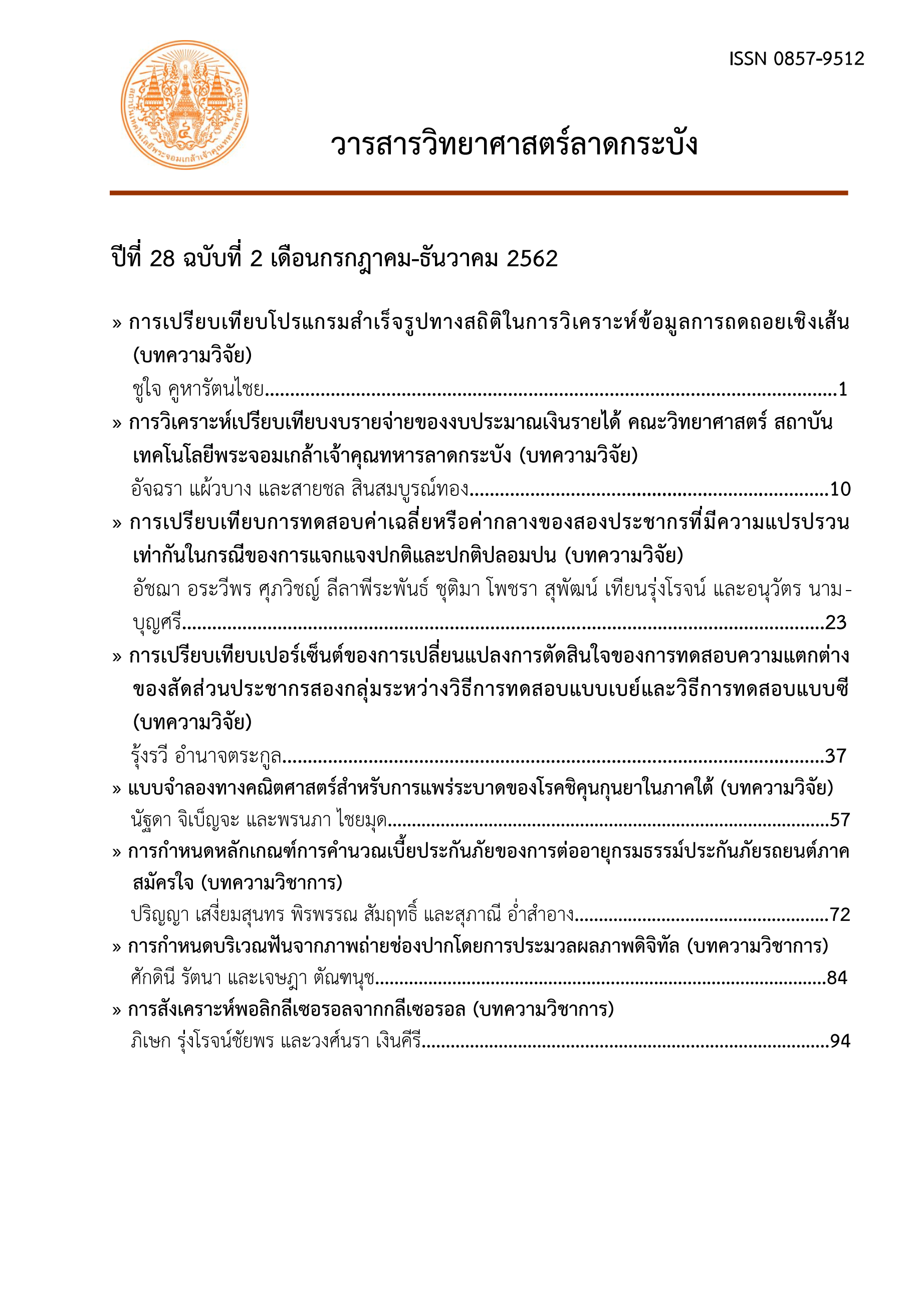Determining Conditions for Calculation of Premium of Voluntary Motor Insurance Renewal Policy
Main Article Content
Abstract
บทคัดย่อ
ในงานวิจัยนี้จะศึกษาการคำนวณเบี้ยประกันภัยการต่ออายุกรมธรรม์ประกันภัยรถยนต์ภาคสมัครใจโดยใช้ตัวแบบเชิงเส้นวางนัยทั่วไปจากข้อมูลประวัติการเรียกร้องค่าสินไหมทดแทนย้อนหลัง 1 ถึง 3 ปี ซึ่งในการสร้างตัวแบบคำนวณเบี้ยประกันภัยนั้นจะมีการจัดกลุ่มตามอัตราส่วนความเสียหาย ซึ่งแบ่งออกเป็น 4 กลุ่ม ดังนี้ กลุ่มที่ 1 อัตราส่วนความเสียหาย 0% กลุ่มที่ 2 อัตราส่วนความเสียหาย มากกว่า 0% ถึง 50% กลุ่มที่ 3 อัตราส่วนความเสียหายมากกว่า 50% ถึง 100% และกลุ่มที่ 4 อัตราส่วนความเสียหายมากกว่า 100% แล้วทำการจัดกลุ่มลูกค้าที่มีลักษณะพฤติกรรมการขับขี่ใกล้เคียงกันโดยใช้วิธีการอัลกอริทึมเคมีน (K-Means Algorithm) โดยจำแนกจากทุนประกันภัยและอัตราส่วนความเสียหาย แบ่งออกเป็น 3 กลุ่ม จากนั้นทำการเปรียบเทียบตัวแบบการคำนวณเบี้ยประกันภัยที่คำนวณได้กับเบี้ยประกันภัยเดิมของบริษัทให้เหมาะสมกับกลุ่มลูกค้า โดยพิจารณาจากผลต่างของเบี้ยประกันภัยที่คำนวณได้กับเบี้ยประกันภัยเดิมของบริษัทและเบี้ยประกันภัยที่คำนวณได้ต้องเพียงพอต่อความเสียหายที่เกิดขึ้นจริง ซึ่งจากผลการเปรียบเทียบพบว่า กลุ่มที่ 1 ควรกำหนดให้ใช้เบี้ยประกันภัยของบริษัท ส่วนในกลุ่มที่ 2 และกลุ่มที่ 3 ควรกำหนดให้ใช้เบี้ยประกันที่คำนวณโดยใช้ประวัติการเรียกร้องค่าสินไหมทดแทนย้อนหลัง 3 ปี ซึ่งหากเลือกใช้เบี้ยประกันภัยตามแผนนี้จะช่วยให้บริษัทมีรายได้ก่อนหักค่าใช้จ่ายเพิ่มสูงขึ้นแล้วยังเป็นแนวทางในการกำหนดเบี้ยประกันภัยตามลักษณะของกลุ่มลูกค้า อีกทั้งจะช่วยส่งเสริมการรักษาอัตราการต่ออายุของลูกค้าไว้ได้
คำสำคัญ : ค่าสินไหมทดแทน ตัวแบบเชิงเส้นวางนัยทั่วไป เบี้ยประกันภัย ประกันภัยรถยนต์ภาคสมัครใจ อัตราส่วนความเสียหาย
Abstract
This research aims to study and determine the renewed premium rate for motor insurance which can suitably reflect individual driving behavior. This research proposes a pricing method of premium using Generalized Linear Models (GLMs) on the previous claims history data from 1 to 3 years. To obtain the pricing model, previous claims data are separated into 4 groups by loss ratio as follows: The first group has loss ratio 0%, the second group has loss ratio more than 0% to 50%, the third group has loss ratio more than 50% to 100% and the last group has loss ratio more than 100%. Then, customers are clustered into 3 groups of similar driving behavior by using K-Means Algorithm based on the sum insured and loss ratio. Finally, the premium which is calculated from the proposed models are compared with the original premium of the insurance company by considering the difference of the total premium calculated from the model and the original premium of the company. As the total premium must be sufficient for the actual damage, it is found that the first group of customers should be assigned the original premium of the company, the second and the third groups of customers should be assigned the premium calculated from the model based on previous claim history of 3 years. By using this pricing plan, the company could generate more income (before deducting expense). In addition, it can be used as a guideline to determine the insurance premium according to characteristics of customers and to maintain the rate of renewal of the customers.
Keywords: Claim, Generalized Linear Model, Premium, Loss ratio, Voluntary Motor Insurance

